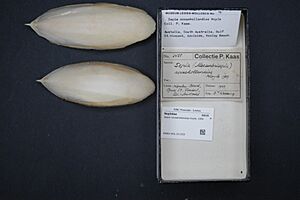Sepia novaehollandiae facts for kids
Quick facts for kids Sepia novaehollandiae |
|
|---|---|
 |
|
| Cuttlebone from Sepia novaehollandiae at Rijksmuseum van Natuurlijke Historie, Leiden | |
| Conservation status | |
| Scientific classification | |
| Genus: |
Sepia
|
| Species: |
novaehollandiae
|
| Synonyms | |
|
|
Sepia novaehollandiae is a type of cuttlefish. It lives in the southern Indo-Pacific Ocean. You can find it from Shellharbour, New South Wales, all the way to the North West Shelf in Western Australia. This cuttlefish makes its home in the ocean at depths from about 15 meters to 348 meters deep.
What Does This Cuttlefish Look Like?
The first Sepia novaehollandiae ever studied was found near Kangaroo Island, South Australia. A scientist named Hoyle described this species in 1909.
Sepia novaehollandiae can grow quite large. Its body, called the mantle, can reach about 77 millimeters long. Some cuttlefish from Spencer Gulf can be even bigger. They can have mantles around 125 millimeters long. We have even found cuttlebones from these animals that are up to 170 millimeters long!
Special Cuttlefish from Spencer Gulf
Cuttlefish found in Spencer Gulf, South Australia, are usually around 125 millimeters long. They weigh up to 521 grams. Their body is long and oval-shaped. It has thin fins on the sides.
These cuttlefish are typically brown. They have small white spots all over their body. Their arms do not have any special patterns. In 2015, a scientist named Mike Steer described their cuttlebone. He said it is long and oval, getting narrower at both ends. The back of the cuttlebone often has a pinkish color. It also has tiny bumps that become smaller towards the front.
Cuttlefish and Fishing
People do not usually fish for Sepia novaehollandiae on purpose in South Australia. However, they are sometimes caught by accident. This happens when people are fishing for other types of fish. They are also caught in nets used for trawling.
It can be hard to tell Sepia novaehollandiae apart from young Sepia apama. This is because they look similar. They also live in the same areas. The Spencer Gulf Prawn Fishery catches more Sepia novaehollandiae than other cuttlefish species. These include Sepia apama and Sepia braggi.


